Places visited in this part of the trip:
Bladensburg National Park
Winton
Kynuna
McKinlay
Cloncurry
Burke and Wills Roadhouse
Gregory River
Lawn Hill National Park and Adel’s Grove
Doomadgee
In the first installment of this trip, we had got as far as Longreach, Queensland, and were heading northwest.
Here is a map of the trip (click to see it larger): 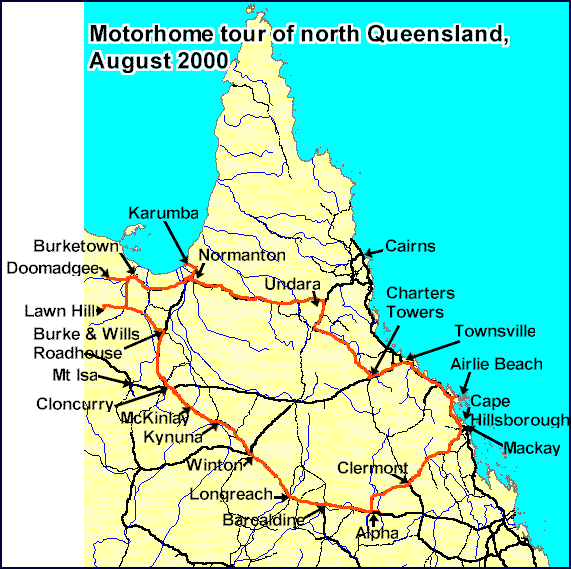 .
.
Bladensburg National Park
From Longreach we drove northwest along the Lansborough Highway (also known as the Matilda Highway) through gently rolling grassland to Winton, then turned south on a dirt road into Bladensburg National Park.
Despite being confused by a lot of 4WD tracks running in all directions, we found the ranger’s office (unattended) and filled out a camping permit form. Leaving there, we drove awhile on the wrong unmarked track, then found the correct track and finally got to the camping area at Bough Shed Hole.
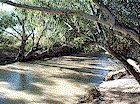
 Surprisingly, no one else was there. It was a very pleasant spot, with one clean pit toilet, but you needed to bring everything else, including water. The campsite was by a rather muddy waterhole, and we could hear the occasional moo and baa in the underbrush, but we saw no wildlife except for quite a few birds (and flies). It was such a nice, quiet spot that we stayed for two nights, despite the lack of a shower. During the day three vehicles came by but no one else stayed overnight.
Surprisingly, no one else was there. It was a very pleasant spot, with one clean pit toilet, but you needed to bring everything else, including water. The campsite was by a rather muddy waterhole, and we could hear the occasional moo and baa in the underbrush, but we saw no wildlife except for quite a few birds (and flies). It was such a nice, quiet spot that we stayed for two nights, despite the lack of a shower. During the day three vehicles came by but no one else stayed overnight.
In dry weather, you could get through to the camping areas and other sights in this park without a 4WD vehicle (though high ground clearance would be useful in places), but the depth of some of the ruts indicated that a bit of rain would turn many of the tracks into serious mud.
For more information, you can contact The Ranger, Bladensburg National Park,
Winton, Qld 4735, phone (07) 4657 1192.
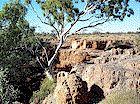 On the second day, as we drove back to Winton, we stopped to looked at two other waterholes in the area, one in a gorge. We decided against taking the dirt track to Lark Quarry to see the dinosaur stampede tracks, although the brochure made them sound well worth a visit.
On the second day, as we drove back to Winton, we stopped to looked at two other waterholes in the area, one in a gorge. We decided against taking the dirt track to Lark Quarry to see the dinosaur stampede tracks, although the brochure made them sound well worth a visit.
Winton
 The Winton district was settled in 1873 when rural properties, including Bladensburg, were founded. Originally known as Pelican Waterhole (guess why), the town claims that Banjo Paterson’s Waltzing Matilda had its first public performance on 6 April 1895 in the North Gregory Hotel (which has burnt down and been rebuilt at least twice since then). The first board meeting of Qantas was also held in the town, in 1921. The Bronze Swagman Bush Poetry competition has been held there since 1972.
The Winton district was settled in 1873 when rural properties, including Bladensburg, were founded. Originally known as Pelican Waterhole (guess why), the town claims that Banjo Paterson’s Waltzing Matilda had its first public performance on 6 April 1895 in the North Gregory Hotel (which has burnt down and been rebuilt at least twice since then). The first board meeting of Qantas was also held in the town, in 1921. The Bronze Swagman Bush Poetry competition has been held there since 1972.
 One of the stranger sights in Winton is Arno’s Wall, made of metal, plastic, ceramic and other junk from the tip (dump) held together with concrete. Among other cast-off materials are two motorcycles, artistically arranged.
One of the stranger sights in Winton is Arno’s Wall, made of metal, plastic, ceramic and other junk from the tip (dump) held together with concrete. Among other cast-off materials are two motorcycles, artistically arranged.
 We visited the hotel and lunched at the Matilda Centre Qantilda museum, but felt museumed out and didn’t enter. The museum includes an early Qantas display, pioneering displays, historic modes of transport, early medical equipment, a bottle collection, an Aboriginal section, and more. http://www.matildacentre.com.au
We visited the hotel and lunched at the Matilda Centre Qantilda museum, but felt museumed out and didn’t enter. The museum includes an early Qantas display, pioneering displays, historic modes of transport, early medical equipment, a bottle collection, an Aboriginal section, and more. http://www.matildacentre.com.au
Kynuna
 We stopped for the day at the tiny town of Kynuna (population between 12 and 18) and stayed at the Jolly SwagVan caravan park run by the historic Blue Heeler Hotel, which had a good-looking area with a few trees separating the half dozen powered sites. The interesting fireplace in the pub was funded by R.M. Williams, whose contributions turned up in several country towns. Phone (07) 4746 8650, fax (07) 4946 8643 for Blue Heeler Hotel.
We stopped for the day at the tiny town of Kynuna (population between 12 and 18) and stayed at the Jolly SwagVan caravan park run by the historic Blue Heeler Hotel, which had a good-looking area with a few trees separating the half dozen powered sites. The interesting fireplace in the pub was funded by R.M. Williams, whose contributions turned up in several country towns. Phone (07) 4746 8650, fax (07) 4946 8643 for Blue Heeler Hotel.
We could have also used the Never Never Caravan Park next to the nearby roadhouse, but that was a very open parking lot and it looked to us as if the trucks might be parking there and making lots of noise. We could even have camped by Magoffin’s Matilda Expo for free, down by their pretty billabong.
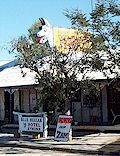 We had a pretty good dinner from Hector and Nicole at the Blue Heeler historic pub, where the last brawl of the Shearer’s Strike of 1891 was settled, after the burning of the Dogwood shearing shed and the seige. We paused to check the neon blue heeler (dog) with the flashing red neon tongue on top of the pub.
We had a pretty good dinner from Hector and Nicole at the Blue Heeler historic pub, where the last brawl of the Shearer’s Strike of 1891 was settled, after the burning of the Dogwood shearing shed and the seige. We paused to check the neon blue heeler (dog) with the flashing red neon tongue on top of the pub.
 Eric attended a performance by Richard Magoffin, OAM, at his Matilda Expo museum that evening. This showman and historian puts on a great show at 7:30 each evening, for $12. After a dramatic entrance, he tells the real story of Waltzing Matilda, in one of the towns where the song started, placing it in the social and political context of the day. He even gets the audience to sing along as he plays the variations from the 18th Century that lead to the final tune. His own ballads and songs are pretty good too. Phone (07) 4746 8401
Eric attended a performance by Richard Magoffin, OAM, at his Matilda Expo museum that evening. This showman and historian puts on a great show at 7:30 each evening, for $12. After a dramatic entrance, he tells the real story of Waltzing Matilda, in one of the towns where the song started, placing it in the social and political context of the day. He even gets the audience to sing along as he plays the variations from the 18th Century that lead to the final tune. His own ballads and songs are pretty good too. Phone (07) 4746 8401
We were one week too early for the annual surf carnival, in aid of the Royal Flying Doctor Service, where lifeboats parade the street, hundreds of kilometres from the nearest surf.
McKinlay
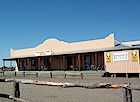
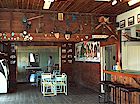 After Kynuna we drove to McKinlay, notable only because it has the Walkabout Creek hotel used in the Crocodile Dundee movies. Naturally we had to stop and have a drink there. There was virtually nothing else in the town. Phone (07) 4746 8424, fax (07) 4746 8768.
After Kynuna we drove to McKinlay, notable only because it has the Walkabout Creek hotel used in the Crocodile Dundee movies. Naturally we had to stop and have a drink there. There was virtually nothing else in the town. Phone (07) 4746 8424, fax (07) 4746 8768.
Cloncurry
On to Cloncurry, on the main road west from Townsville to Mt Isa and the Northern Territory. Although it’s not a large town (around 4,000 people), it’s the biggest we’ll see for a couple of weeks, so we stocked up on food and fuel. Local sights include a Flying Doctor Museum, an art gallery, a cultural centre, an outdoor theatre, and the Mary Kathleen Museum (containing memorabilia from the closed MK uranium mine).
Burke and Wills Roadhouse
 We continued on north, stopping at the Quamby pub for a soft drink, and then on to the Burke and Wills Roadhouse, where we stayed overnight at their caravan park. They had a few large powered sites with concrete pads sheltered by a large high roof providing some shade. It was a much better site than many we’ve seen. We had a really nice lamb chop dinner (and a few beers) on their verandah.
We continued on north, stopping at the Quamby pub for a soft drink, and then on to the Burke and Wills Roadhouse, where we stayed overnight at their caravan park. They had a few large powered sites with concrete pads sheltered by a large high roof providing some shade. It was a much better site than many we’ve seen. We had a really nice lamb chop dinner (and a few beers) on their verandah.
 The road north of Cloncurry is a typical Queensland outback road, with one lane of bitumen (blacktop, asphalt) down the middle and half a lane of gravel or dirt on each side. You drive on the bitumen until you get within a few hundred metres of a vehicle coming in the opposite direction, then both vehicles dodge off onto the sides of the road (usually keeping their right tyres on the bitumen) until they’ve passed each other. Unless, of course, one vehicle is a road train—in this case, it’s prudent for the other vehicle to get completely off the road and let the truck have the bitumen to itself.
The road north of Cloncurry is a typical Queensland outback road, with one lane of bitumen (blacktop, asphalt) down the middle and half a lane of gravel or dirt on each side. You drive on the bitumen until you get within a few hundred metres of a vehicle coming in the opposite direction, then both vehicles dodge off onto the sides of the road (usually keeping their right tyres on the bitumen) until they’ve passed each other. Unless, of course, one vehicle is a road train—in this case, it’s prudent for the other vehicle to get completely off the road and let the truck have the bitumen to itself.
Although our truck isn’t as big as a road train, we did notice a tendency for most smaller vehicles to get off the road when they saw us coming—possibly to avoid being hit by any stones we might kick up.
Gregory River
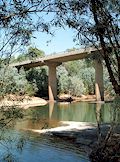 From Burke and Wills, we headed west, still on a paved road (as described above), crossing the Leichhardt River on a fairly new, high-level bridge, from which we could look down on the old causeway across the river. As with most rivers in outback Queensland, the water level is low in the middle of the dry season, but you can easily see how high the water gets during the wet, quickly making the causeway impassable.
From Burke and Wills, we headed west, still on a paved road (as described above), crossing the Leichhardt River on a fairly new, high-level bridge, from which we could look down on the old causeway across the river. As with most rivers in outback Queensland, the water level is low in the middle of the dry season, but you can easily see how high the water gets during the wet, quickly making the causeway impassable.
 Eventually we reached the Gregory River, where there was Billy Hanger’s general store and canoe hire (phone 07 47485540), and the Gregory Downs Hotel (phone 07 47485566, fax 47485501), which had the most broken down toilets we’ve ever seen. The new Council toilets and showers across the road were in somewhat better condition, though a bit primitive. This is not a complaint, just an observation. You get used to corrugated iron sheds after awhile, and it’s part of the outback experience. At least the shower water was hot, the toilet flushed, the place was clean, and there was a bench on which to put your clean clothes; what more do you need?
Eventually we reached the Gregory River, where there was Billy Hanger’s general store and canoe hire (phone 07 47485540), and the Gregory Downs Hotel (phone 07 47485566, fax 47485501), which had the most broken down toilets we’ve ever seen. The new Council toilets and showers across the road were in somewhat better condition, though a bit primitive. This is not a complaint, just an observation. You get used to corrugated iron sheds after awhile, and it’s part of the outback experience. At least the shower water was hot, the toilet flushed, the place was clean, and there was a bench on which to put your clean clothes; what more do you need?
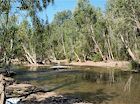 We’d been told from people who’d stayed there last year that the river bed at the Gregory River (a few hundred yards from the Hotel) was a very nice place to camp, so we stayed there overnight and almost got bogged in deep sand. Unfortunately, this year a new bridge is under construction, and half the camping area is occupied by earth-moving machines making lots of noise. Despite this, there were over a dozen caravans, tents and motorhomes already camped there, taking all the good spots by the river.
We’d been told from people who’d stayed there last year that the river bed at the Gregory River (a few hundred yards from the Hotel) was a very nice place to camp, so we stayed there overnight and almost got bogged in deep sand. Unfortunately, this year a new bridge is under construction, and half the camping area is occupied by earth-moving machines making lots of noise. Despite this, there were over a dozen caravans, tents and motorhomes already camped there, taking all the good spots by the river.
We walked along the river for awhile, and it did look very pleasant, with nice swimming holes (and no crocodiles). We checked the pub for dinner, and found they were doing a $10 all-you-can-eat barbeque, with really great serves of salad, plus fish, steak, hamburger and snags (sausages). I guess having a road-building crew resident in the hotel helped encourage them to put on a big feed.
Lawn Hill National Park and Adel’s Grove
Unimpressed with the bridge constuction, we declined to stay another day at Gregory River, so we drove the 100 km of dirt road to Lawn Hill National Park. The condition of this road varied from fairly smooth to bone-jarringly rough, so we drove very slowly and took nearly 3 hours to get there. People in smaller vehicles with better suspension were making better time.

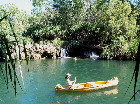 We could only visit Lawn Hill as day vsitors, as the camping area there was full. (They always advise booking ahead.) We took a few nice walks through forest to the Cascades and to Indarri Falls, but we didn’t have the ambition to walk as far as the Upper Gorge or take a canoe through the Middle and Upper Gorges, but everyone said that was the best way to see the area. You can bring your own canoe or hire one there for quite reasonable rates.
We could only visit Lawn Hill as day vsitors, as the camping area there was full. (They always advise booking ahead.) We took a few nice walks through forest to the Cascades and to Indarri Falls, but we didn’t have the ambition to walk as far as the Upper Gorge or take a canoe through the Middle and Upper Gorges, but everyone said that was the best way to see the area. You can bring your own canoe or hire one there for quite reasonable rates.
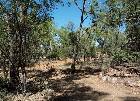 We stayed overnight about 10 km away, at Adel’s Grove, a spacious and nicely laid out camping area in wonderful grounds. They have good showers and toilets but no mains electricity (using a generator for power) or drinking water (bring your own or boil their river water). Fortunately they turn the generator off at 9 p.m., so it wasn’t noisy at night. Early in the morning, as we boiled the billy, an agile wallaby visited us.
We stayed overnight about 10 km away, at Adel’s Grove, a spacious and nicely laid out camping area in wonderful grounds. They have good showers and toilets but no mains electricity (using a generator for power) or drinking water (bring your own or boil their river water). Fortunately they turn the generator off at 9 p.m., so it wasn’t noisy at night. Early in the morning, as we boiled the billy, an agile wallaby visited us.
Phone (07) 4748 5502; postal address PMB 2, Mt Isa Q 4825. This was such a pleasant place, and so few people were there, that we would have stayed another day or two, but we had people to meet at our next stop, so we went on the next day.
Doomadgee
After driving back over that dirt road to Gregory Downs, we continued north on a much better dirt road. When we met the Great Top Road (25 km west of Burketown), we turned west. A few km along, we passed the Tirranna Roadhouse, which closed a few years ago when the owners just walked away one day, and is now a deserted ruin with no facilities.
The Great Top Road is considered 4WD only, and definitely would be in wet weather (if you could get through at all), but despite being fairly rough it was no problem at the time we visited. When we got to the Doomadgee turnoff, the road became much worse. We reached the town in late afternoon and sought directions to the hospital, where we were greeted by our friends, a doctor and nurse. We stayed with them for several days, collecting our e-mail, washing clothes, and visiting.
Doomadgee has an Aboriginal population of around 1500. It is on Aboriginal land, under the control of an Aboriginal council, and we had to apply to them for permission to stay. Sale of alcohol is banned in the town, so we were discreet about our supplies. The place was run-down and depressing, but the store had good stocks of fresh food, and our friends introduced us to some of the resident Aboriginal people who are trying to improve the town. There’s little employment available locally, though some of the men work at the Pasminco Century zinc mine near Lawn Hill.
The hospital is well-supplied and well-run, and has some of the video conferencing gear that is being supplied to all Queensland regional hospitals. Our doctor friend uses this equipment to keep his patients (who have been transferred to larger hospitals in Townsville and other places) in touch with their extended families. This is good for everyone’s morale. He also uses it for conferences with specialist doctors, as an aid in diagnosis and treatment.
The final leg of this trip is described on this page. We visited Burketown, Normanton, Karumba, the Undara lava tubes, and Charters Towers. Along the way we took a short trip on the Gulflander train out of Normanton.
